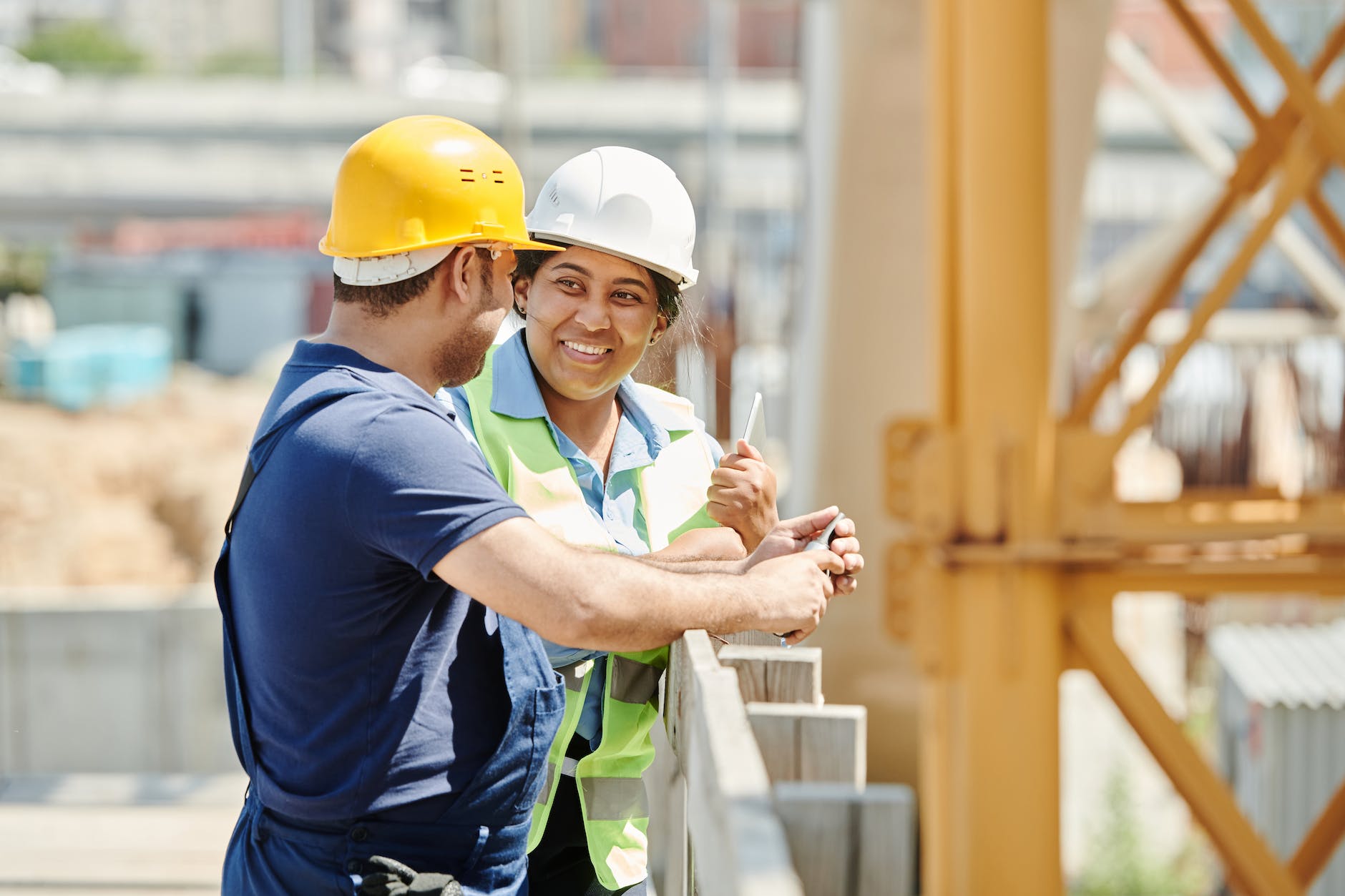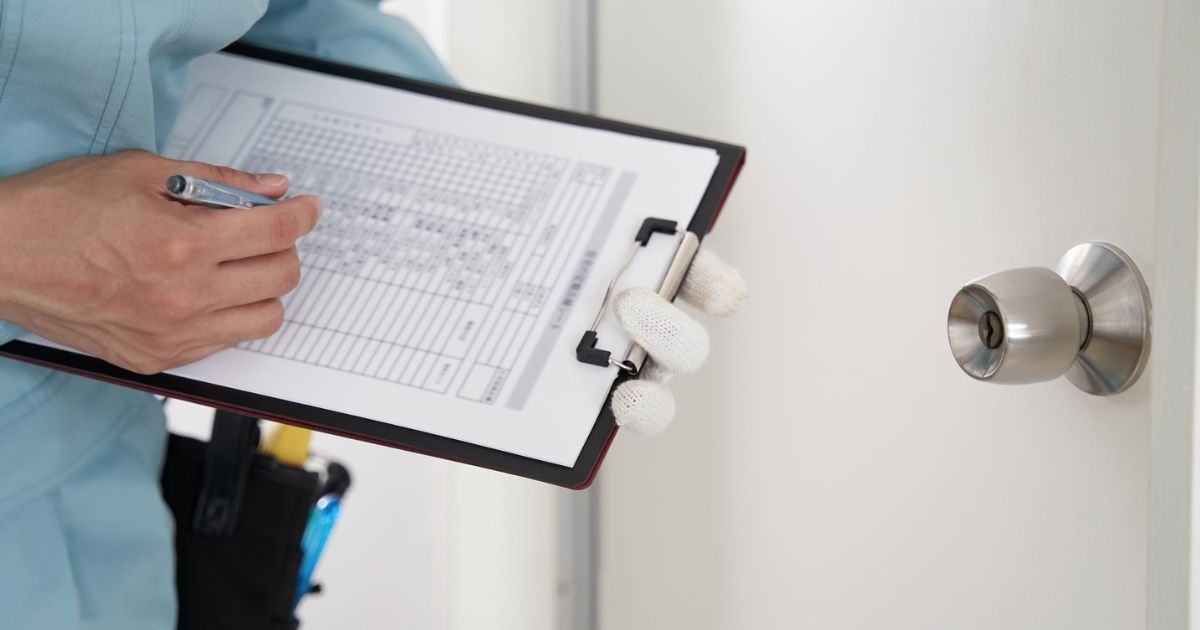Home>diy>Building & Construction>How To Be A Construction Safety Officer


Building & Construction
How To Be A Construction Safety Officer
Modified: May 6, 2024
Learn the essential steps to becoming a construction safety officer in the building construction industry. Gain the necessary skills and knowledge to ensure safety on construction sites.
(Many of the links in this article redirect to a specific reviewed product. Your purchase of these products through affiliate links helps to generate commission for Storables.com, at no extra cost. Learn more)
Introduction
Welcome! In the fast-paced and ever-evolving construction industry, safety is of paramount importance. Construction sites are known for their potential hazards, and it is crucial to have trained professionals who can ensure the well-being of workers and prevent accidents. Enter the Construction Safety Officer – a vital role responsible for implementing and enforcing safety protocols on construction sites.
As a Construction Safety Officer, you play a crucial role in safeguarding the lives and well-being of workers on construction sites. Your main objective is to ensure that all safety regulations and guidelines are followed, minimizing the risk of accidents and injuries. From implementing safety procedures to conducting inspections and investigations, your actions can make a significant difference in maintaining a safe working environment.
In this article, we will explore the roles and responsibilities of a Construction Safety Officer. We will also discuss the essential skills and qualifications needed for this role, as well as the importance of staying up-to-date with safety regulations.
So, if you’re ready to dive into the world of construction safety and learn how to become a Construction Safety Officer, let’s get started!
Key Takeaways:
- Construction Safety Officers play a vital role in ensuring the well-being of workers by implementing safety procedures, conducting inspections, and collaborating with stakeholders to create a safety-focused culture on construction sites.
- Staying up-to-date with safety regulations, training workers, and actively addressing construction site hazards are essential responsibilities of Construction Safety Officers, contributing to a safer future for the construction industry.
Responsibilities of a Construction Safety Officer
As a Construction Safety Officer, your primary responsibility is to ensure the safety and well-being of all individuals on a construction site. This includes workers, visitors, and the general public. Let’s take a closer look at some of the key responsibilities that fall under your purview:
- Develop and implement safety policies and procedures: You are responsible for developing comprehensive safety policies and procedures that comply with local regulations and industry standards. These policies should cover areas such as personal protective equipment (PPE), hazard communication, fall protection, electrical safety, and more.
- Monitor and enforce safety guidelines: As a Construction Safety Officer, you must monitor and enforce safety guidelines at all times. This includes conducting regular inspections to identify potential hazards and ensuring that all workers are following safety protocols. You have the authority to stop work if safety standards are not being met.
- Provide safety training: It is important to educate workers on safety procedures and practices. You will be responsible for organizing and conducting safety training sessions to ensure that workers understand the potential risks and how to mitigate them. This includes training on the proper use of equipment, handling hazardous materials, and responding to emergencies.
- Investigate accidents and incidents: In the unfortunate event of an accident or incident, you will be responsible for conducting a thorough investigation to determine the root cause. This includes gathering evidence, interviewing witnesses, and analyzing data to identify any lapses in safety protocols. Based on your findings, you will recommend corrective actions to prevent future occurrences.
- Maintain safety records and documentation: Accurate and up-to-date documentation is crucial in maintaining a safe working environment. You will be responsible for keeping records of safety inspections, trainings, incident reports, and any corrective actions taken. These records will be essential for regulatory compliance and continuous improvement.
- Collaborate with stakeholders: Building strong relationships with site managers, contractors, and other stakeholders is crucial for effective safety management. You will work closely with these individuals to ensure that safety measures are integrated into project planning and execution. Collaboration and open communication are key to fostering a safety-first culture.
- Stay informed about industry trends and regulations: Construction safety is a dynamic field, and regulations and best practices are constantly evolving. It is imperative that you stay up-to-date with the latest industry trends, technological advancements, and regulatory changes. This will enable you to effectively implement new safety measures and continuously improve the safety standards on the construction site.
These are just a few of the responsibilities that a Construction Safety Officer typically undertakes. It’s a challenging yet rewarding role that requires strong leadership, attention to detail, and a genuine commitment to ensuring the safety of every individual involved in a construction project.
Education and Certification Requirements
To become a Construction Safety Officer, there are certain education and certification requirements that you need to fulfill. While the specific requirements may vary depending on your location and employer, here are some general guidelines:
Education:
Most employers require a minimum of a high school diploma or equivalent. However, having a degree in Occupational Health and Safety, Construction Management, or a related field can give you a competitive edge and provide a deeper understanding of the principles and practices of construction safety. Additionally, taking courses or obtaining certifications in specific areas of construction safety, such as fall protection or hazardous materials handling, can further enhance your qualifications.
Certifications:
Obtaining relevant certifications in construction safety is highly beneficial and can demonstrate your competence and commitment to the field. Two widely recognized certifications for Construction Safety Officers are the Construction Health and Safety Technician (CHST) certification and the Certified Safety Professional (CSP) certification. These certifications require a combination of experience, education, and passing a comprehensive examination.
Experience:
While not always a requirement, having practical experience in the construction industry can greatly enhance your credibility as a Construction Safety Officer. Prior experience working in construction, whether as a laborer, supervisor, or project manager, can provide valuable insights into the unique challenges and hazards present on construction sites. It can also help you better understand the needs and perspectives of workers and build strong relationships with them.
Continuing Education:
Construction safety practices and regulations evolve constantly, so it’s crucial to stay current with the latest developments. Attending workshops, conferences, and seminars related to construction safety can help you stay informed about industry best practices and emerging trends. Additionally, subscribing to relevant publications, participating in online forums, and engaging in professional networking can all contribute to your ongoing education and growth as a Construction Safety Officer.
Remember, the specific educational and certification requirements may vary depending on your geographic location and the type of construction projects you will be working on. Researching and understanding the requirements set by local regulatory bodies and industry organizations can help guide your educational and certification pursuits.
By acquiring the necessary education and certifications, you can establish yourself as a competent and knowledgeable Construction Safety Officer, ready to take on the responsibilities of ensuring a safe and secure construction environment.
Essential Skills and Qualities
Being a Construction Safety Officer requires a unique combination of skills and qualities to effectively manage and promote a safe working environment. While technical knowledge and experience are crucial, there are several key skills and qualities that can set you apart as a competent and successful Construction Safety Officer:
1. In-depth knowledge of construction safety regulations and standards: A strong understanding of local and national safety regulations is essential. You should be familiar with codes, standards, and guidelines related to construction safety, including OSHA (Occupational Safety and Health Administration) regulations. Staying updated on changes to safety requirements and industry best practices is crucial in ensuring compliance and implementing effective safety measures.
2. Excellent communication skills: Effective communication is vital in this role. You will be interacting with various stakeholders, including workers, contractors, and management. Clear and concise communication ensures that safety protocols and procedures are understood and followed by all. Additionally, strong communication skills are essential when conducting safety training sessions, delivering safety instructions, and conducting accident investigations.
3. Strong attention to detail: As a Construction Safety Officer, you must have a keen eye for identifying potential hazards and risks. A meticulous approach to observing construction processes, inspecting equipment, and reviewing safety protocols is crucial in preventing accidents and maintaining a safe work environment. Attention to detail can make the difference between preventing a potential incident and facing a serious safety issue.
4. Problem-solving and decision-making abilities: Construction sites are dynamic environments with constantly changing conditions. As a Construction Safety Officer, you must possess strong problem-solving and decision-making skills to effectively manage safety challenges that arise. The ability to assess risks, evaluate options, and make sound decisions quickly is crucial for maintaining a safe working environment.
5. Leadership and interpersonal skills: You will be responsible for influencing and guiding others towards a safety-first culture. Strong leadership skills, including the ability to motivate and inspire workers, are essential. Building positive relationships with workers and stakeholders, as well as effectively resolving conflicts, is crucial for creating an environment where safety is prioritized and embraced by all.
6. Flexibility and adaptability: Construction projects are known for their ever-changing nature. As a Construction Safety Officer, you must be flexible and adaptable to accommodate fluctuating priorities, timelines, and work conditions. The ability to adjust safety plans and strategies accordingly ensures that safety remains a constant focus, regardless of project circumstances.
7. Strong analytical and problem-solving skills: Construction safety often requires evaluating complex situations and identifying effective solutions. The ability to analyze data, assess risks, and formulate innovative safety strategies is crucial for protecting the well-being of workers and minimizing potential hazards on construction sites.
By possessing and continuously developing these skills and qualities, you can excel as a Construction Safety Officer and contribute to creating a safer working environment in the construction industry.
Understanding Construction Site Hazards
As a Construction Safety Officer, it is essential to have a comprehensive understanding of the various hazards that can be present on construction sites. By identifying and recognizing these hazards, you can implement the necessary safety measures to prevent accidents and injuries. Let’s take a closer look at some common construction site hazards:
- Falls: Falls are one of the leading causes of fatalities and injuries in the construction industry. Elevated working surfaces, such as scaffolds, ladders, and roofs, pose a significant risk. It is crucial to ensure that workers have access to proper fall protection systems, including guardrails, safety nets, and personal fall arrest systems.
- Electrical hazards: Construction sites often have electrical systems in place, which can present hazards if not properly managed. Workers may come into contact with live wires, faulty equipment, or damaged electrical systems. Implementing lockout/tagout procedures, providing adequate training, and ensuring proper grounding and insulation can help mitigate electrical hazards.
- Excavation and trenching hazards: Construction projects involving excavation and trenching pose unique risks. Workers can be exposed to cave-ins, soil collapse, and the potential for encountering underground utilities. Shoring, sloping, or installing protective systems, along with proper training and regular inspections, are essential to prevent accidents in excavation areas.
- Heavy machinery and equipment: Construction sites are filled with heavy machinery and equipment, including cranes, bulldozers, and excavators. Improper use, improper maintenance, or lack of training can lead to accidents and injuries. Ensuring that workers are adequately trained, providing clear operating instructions, and implementing strict safety protocols around machinery can help minimize these hazards.
- Hazardous materials: Construction projects often involve the use, handling, and storage of hazardous materials, such as chemicals, asbestos, and lead. Exposure to these substances can result in serious health issues. Effectively managing and disposing of hazardous materials, providing workers with proper personal protective equipment (PPE), and conducting regular air monitoring are essential to mitigate these risks.
- Fire and explosion hazards: Construction sites can be susceptible to fire and explosion hazards due to the presence of flammable materials, fuel sources, and activities such as welding and cutting. Proper fire prevention measures, including the availability of fire extinguishers, clear evacuation plans, and fire-resistant materials, are crucial to minimize the risk of fire-related incidents.
These are just a few examples of the hazards that can be encountered on construction sites. It is important to perform a thorough hazard assessment specific to each project and implement appropriate control measures accordingly. Regular inspections, hazard identification, and ongoing communication with workers are vital to maintaining a safe working environment.
By understanding and actively addressing these hazards, you can play a significant role in mitigating risks and ensuring the safety of all individuals involved in construction projects.
Read more: How To Stop A Squeaky Office Chair
Implementing Safety Procedures and Protocols
Implementing safety procedures and protocols is a critical responsibility of a Construction Safety Officer. It involves developing comprehensive plans and guidelines to ensure the well-being of workers and the overall safety of the construction site. Let’s delve into the key steps involved in this process:
- Conduct a thorough hazard assessment: Before implementing safety procedures, it is important to conduct a comprehensive hazard assessment of the construction site. This assessment helps identify potential hazards, evaluate risks, and determine the appropriate control measures. By understanding the specific hazards present, you can tailor your safety procedures to address them effectively.
- Develop written safety policies and procedures: Written safety policies and procedures provide clear guidelines and expectations for all workers. These policies should cover topics such as personal protective equipment (PPE) requirements, hazard communication, equipment operation, emergency response procedures, and more. Ensure that the policies are accessible to all workers and are regularly reviewed and updated as needed.
- Provide training on safety procedures: Conduct regular safety training sessions to educate workers on the established safety procedures and protocols. Training should include topics such as hazard identification, proper equipment usage, emergency procedures, and the importance of following safety guidelines. Providing workers with the necessary knowledge and skills enables them to actively contribute to maintaining a safe working environment.
- Ensure proper use of personal protective equipment (PPE): Personal protective equipment plays a crucial role in preventing injuries and illnesses. It is essential to establish guidelines on the use, maintenance, and storage of PPE. Regularly inspect and enforce the use of PPE, such as hard hats, safety goggles, gloves, and ear protection, to mitigate risks associated with various hazards.
- Monitor compliance and enforce safety protocols: Regularly monitor the work site to ensure that safety procedures and protocols are being followed. Conduct inspections, observations, and audits to identify any non-compliance issues and address them promptly. Consistently reinforce the importance of adhering to safety protocols to create a culture of accountability and responsibility.
- Promote a culture of safety: Beyond written procedures, fostering a culture of safety is crucial. Encourage workers to actively engage in safety discussions, report potential hazards, and contribute ideas for improving safety practices. Recognize and reward individuals or teams who demonstrate a strong commitment to safety, further encouraging a positive safety culture.
- Regularly review and update procedures: Construction sites are dynamic environments, with changing conditions, processes, and technologies. It is crucial to regularly review and update safety procedures to reflect these changes. Continuously assessing and improving safety protocols allows for greater adaptability and effectiveness in preventing accidents and promoting a safer working environment.
Remember, implementing safety procedures and protocols is an ongoing process. It requires consistent communication, training, and monitoring to ensure that workers are adequately protected from hazards. By proactively implementing and enforcing safety procedures, you can significantly reduce the potential for accidents and injuries on the construction site.
Always prioritize safety over speed. Take the time to properly inspect and address any potential hazards on the construction site to prevent accidents and injuries.
Conducting Safety Inspections
As a Construction Safety Officer, one of your key responsibilities is conducting regular safety inspections on the construction site. Safety inspections play a vital role in identifying potential hazards, assessing the effectiveness of safety procedures, and ensuring compliance with safety regulations. Let’s explore the important steps involved in conducting thorough safety inspections:
- Plan and prepare for the inspection: Before conducting a safety inspection, develop a clear plan outlining the areas to be inspected, the specific hazards to be evaluated, and the inspection checklist to be followed. Familiarize yourself with the construction project, the site layout, and any specific safety concerns relevant to the work being carried out.
- Perform a comprehensive walkthrough: Begin the safety inspection by conducting a thorough walkthrough of the construction site. Observe work practices, equipment usage, and overall safety conditions. Look for potential hazards, such as unsafe scaffolding, inadequate ventilation, unsecured materials, or improper use of tools and equipment. Note any areas of non-compliance with safety regulations.
- Use a checklist: Utilize a comprehensive safety inspection checklist to ensure that all critical areas, equipment, and activities are thoroughly assessed. The checklist should cover a wide range of safety factors, including fall protection, electrical safety, hazard communication, housekeeping, fire prevention, and emergency procedures. Using a checklist helps ensure consistency and completeness in the inspection process.
- Document findings: Document all findings during the safety inspection. Take detailed notes and photographs as evidence of potential hazards or non-compliance. Record specific observations, note any corrective actions that need to be taken, and make recommendations for improvement. Accurate documentation is essential for tracking progress, communicating findings to stakeholders, and implementing necessary changes.
- Address immediate concerns: If you encounter any immediate safety concerns during the inspection, take immediate action to address them. This may involve halting work until the issue is resolved, implementing temporary safety measures, or contacting relevant individuals, such as site managers or contractors, to address the immediate hazard.
- Provide feedback and follow-up: After the safety inspection, provide feedback to the construction team, site managers, and relevant stakeholders. Share your findings and recommendations, emphasizing the importance of addressing any identified issues promptly. Follow up on the implementation of corrective actions, ensuring that they are completed in a timely manner.
- Continuously improve safety practices: Safety inspections should not be seen as one-time events but as an ongoing process. Regularly schedule and conduct follow-up inspections to monitor the progress of safety initiatives and improvements. Analyze trends and patterns in inspection findings to identify areas that require additional attention or training, allowing for continuous improvement in safety practices.
By conducting regular safety inspections, you are actively identifying and addressing potential hazards before they result in accidents or injuries. This proactive approach plays a crucial role in creating a safe working environment for everyone involved in the construction project.
Accident Investigation and Reporting
Accidents can happen on construction sites despite the best safety measures in place. As a Construction Safety Officer, it is crucial to conduct thorough accident investigations to determine the root causes and take necessary corrective actions. Let’s explore the steps involved in accident investigation and reporting:
- Respond promptly to accidents: When an accident occurs, respond immediately to ensure the safety of all individuals involved. Provide first aid or arrange for medical assistance as needed. Secure the accident scene to preserve evidence and prevent further incidents.
- Gather information: Collect information about the accident by interviewing witnesses, involved workers, supervisors, and any other relevant personnel. Gather as much factual information as possible, including the time, location, and sequence of events leading up to the accident.
- Preserve and examine evidence: Preserve any physical evidence related to the accident, such as equipment, tools, or materials involved. Take photographs, measurements, and sketches of the accident scene. Examine the evidence to identify any potential contributing factors or signs of equipment failure or malfunction.
- Analyze contributing factors: Analyze the information and evidence collected to identify the contributing factors that led to the accident. This may include human error, equipment failure, inadequate training, lack of supervision, or communication breakdown. Consider both direct causes and underlying factors that may have contributed to the incident.
- Identify corrective actions: Based on the accident investigation findings, identify and recommend corrective actions to prevent similar incidents from occurring in the future. These corrective actions may include additional training, equipment maintenance, revising safety procedures, enhancing supervision, or improving communication channels.
- Report the accident: Prepare a detailed accident report, documenting the findings of the investigation. Include accurate and objective information about the circumstances leading up to the accident, the contributing factors identified, and the recommended corrective actions. Follow the established reporting procedures and submit the report to the appropriate parties, such as site managers, regulatory authorities, or insurance providers.
- Implement corrective actions: Work with relevant stakeholders to ensure that the recommended corrective actions are implemented promptly. Provide support, resources, and guidance to assist in the implementation process. Regularly follow up to monitor the effectiveness of the corrective actions and make any necessary adjustments.
- Continuously learn and improve: Each accident investigation presents an opportunity to learn and improve safety practices. Use the findings from accident investigations as a basis for ongoing training, improving safety procedures, and raising awareness of potential hazards. Encourage a culture of reporting near-misses or potential hazards to proactively address safety concerns before accidents occur.
Accident investigation and reporting are crucial in preventing future accidents and creating a safer working environment. By conducting thorough investigations, identifying root causes, and implementing corrective actions, you play a pivotal role in improving safety standards and protecting the well-being of all individuals on the construction site.
Training and Educating Workers
One of the key responsibilities of a Construction Safety Officer is to provide training and education to workers on the construction site. By equipping workers with the knowledge and skills to identify and mitigate potential hazards, you can contribute to creating a safer working environment. Let’s explore the essential steps involved in training and educating workers:
- Identify training needs: Assess the specific training needs of the workers on the construction site. Consider factors such as the nature of the construction project, the types of hazards present, and the skills required to work safely. This can be done through surveys, hazard assessments, or discussions with supervisors and workers.
- Develop a comprehensive training program: Based on the identified training needs, develop a comprehensive training program that covers the necessary safety topics and skills. This program should include both general safety training, such as hazard identification, PPE usage, and emergency procedures, as well as job-specific training for tasks involving unique hazards.
- Deliver engaging and interactive training sessions: Implement training methods and techniques that are engaging, interactive, and tailored to the needs of the workers. Utilize a variety of training methods, such as presentations, videos, hands-on demonstrations, and group activities, to ensure that the information is effectively communicated and understood.
- Provide language and literacy support: Recognize the diverse backgrounds and literacy levels of the workers on the construction site. Accommodate language needs by providing training materials in multiple languages if necessary. Use visual aids, graphics, and simple language to enhance comprehension and ensure that all workers can access and understand the training content.
- Include practical demonstrations and simulations: In addition to theoretical knowledge, incorporate practical demonstrations and simulations into the training program. Allow workers to practice using safety equipment, demonstrate proper techniques, and simulate emergency scenarios. This hands-on experience improves retention and reinforces the importance of safety practices.
- Encourage participation and feedback: Create a supportive learning environment that encourages active participation and communication. Encourage workers to ask questions, share their experiences, and provide feedback on the training sessions. Promote open dialogue and address any concerns or misconceptions promptly.
- Provide ongoing training and refresher courses: Safety training should not be a one-time event. Provide ongoing training opportunities and refresher courses to reinforce key safety concepts and address any changes in safety protocols or regulations. This ensures that workers stay updated and knowledgeable about safety practices throughout the duration of the construction project.
- Lead by example: As a Construction Safety Officer, lead by example and practice what you preach. Adhere to safety protocols, wear appropriate PPE, and demonstrate safe work practices at all times. Your behavior sets the tone for the importance of safety, and workers are more likely to follow suit.
By providing comprehensive and engaging training sessions, you empower workers to actively participate in creating a safe working environment. Investing in their safety education not only reduces the risk of accidents and injuries but also cultivates a safety-conscious culture on the construction site.
Read more: How To Raise Office Chair Height
Collaborating with Management and Stakeholders
Collaboration with management and stakeholders is essential for effective safety management on a construction site. As a Construction Safety Officer, building strong relationships and fostering open communication with key individuals and groups is crucial. Let’s explore the importance of collaboration and the steps involved in working harmoniously with management and stakeholders:
1. Establish clear lines of communication: Ensure that there are clear channels of communication with management, site supervisors, contractors, and other stakeholders. Regularly engage in discussions and meetings to exchange information, address concerns, and align safety objectives. This creates a foundation for effective collaboration and decision-making.
2. Involve stakeholders in safety planning: Include management and relevant stakeholders in safety planning processes. Collaborate to identify potential hazards, develop safety procedures, and establish safety goals for the construction site. By involving stakeholders, you can gain valuable insights, enhance buy-in, and increase the commitment to safety.
3. Share safety data and metrics: Regularly share safety data and metrics with management and stakeholders, including accident rates, near-miss reports, and training records. By providing transparent and accurate information, you can collectively evaluate safety performance and identify areas for improvement. This data-driven approach fosters collaboration in implementing targeted safety measures.
4. Coordinate safety efforts with contractors: If multiple contractors are working on the construction site, collaborate closely with them to ensure consistent safety practices across all work areas. Establish mutually agreed upon safety protocols and procedures that align with each contractor’s responsibilities. Regularly communicate and coordinate with contractors to address any safety concerns or changes in site conditions that may impact their work.
5. Seek input and feedback: Actively seek input and feedback from management, workers, and other stakeholders regarding safety policies, procedures, and practices. Encourage open dialogue and create opportunities for them to provide suggestions, ask questions, and share their experiences. This collaboration fosters a sense of ownership and encourages continuous improvement in safety performance.
6. Establish regular safety meetings: Conduct regular safety meetings involving management and relevant stakeholders. These meetings provide a platform for discussing safety-related topics, sharing updates, and addressing emerging issues. Collaboration during these meetings can facilitate the development of proactive strategies, the resolution of safety challenges, and the implementation of preventive measures.
7. Recognize and reward safety achievements: Acknowledge and celebrate achievements in safety performance. Recognize workers, supervisors, and contractors who demonstrate exemplary safety practices or contribute valuable insights. By highlighting and rewarding safety efforts, you foster a positive culture of safety and encourage continuous collaboration and improvement.
Collaboration with management and stakeholders is vital for the successful implementation of safety measures on a construction site. By working together and leveraging the collective expertise and commitment of all parties involved, you can create a culture where safety is a shared responsibility, ultimately ensuring the well-being of everyone involved in the project.
Staying Up-to-Date with Safety Regulations
As a Construction Safety Officer, it is crucial to stay up-to-date with the latest safety regulations and standards in order to effectively manage safety on a construction site. Safety regulations evolve over time, and it is essential to ensure compliance and implement best practices. Here are some key steps to stay up-to-date with safety regulations:
- Regularly review regulatory agencies’ guidelines: Stay informed about the guidelines and regulations provided by regulatory agencies such as OSHA (Occupational Safety and Health Administration), local building departments, and other relevant authorities. Regularly review their websites, publications, and updates to stay abreast of any changes or new requirements related to construction site safety.
- Subscribe to industry publications and newsletters: Subscribe to reputable industry publications and newsletters that focus on construction safety. These resources often provide valuable insights, updates, and interpretations of safety regulations. Stay connected with professional associations and subscribe to their publications to benefit from their expertise and the latest industry trends.
- Attend safety conferences and seminars: Safety conferences and seminars provide opportunities to learn about the latest developments in safety regulations and practices. Attend relevant industry events to gain insights from industry experts, participate in workshops, and interact with peers. These events often feature sessions dedicated to discussing updates in safety regulations, case studies, and emerging trends.
- Participate in safety training and certifications: Engage in safety training programs and certifications to enhance your knowledge and skills in construction safety. These programs often include updates on safety regulations and changes. Pursue certifications, such as the Construction Health and Safety Technician (CHST) or Certified Safety Professional (CSP), which require ongoing education and recertification, ensuring that you stay informed about the latest safety regulations.
- Network with industry professionals: Engage in networking activities and join professional organizations related to construction safety. Attend meetings, webinars, and industry events to connect with other professionals in the field. Collaborating with peers and exchanging information can help you stay informed about regulatory changes and best practices.
- Establish relationships with regulatory authorities: Develop professional relationships with representatives from regulatory agencies and local authorities responsible for enforcing safety regulations. Engage in conversations, seek guidance, and ask questions to ensure a clear understanding of the prevailing regulations. Regularly connect with them to stay informed about any upcoming changes or interpretations.
- Conduct internal audits and reviews: Regularly conduct internal audits and reviews of your safety programs and procedures. Evaluate their effectiveness in meeting regulatory requirements and identify any gaps or areas for improvement. This self-assessment helps you proactively address any deficiencies and align your practices with the most current safety regulations.
- Update safety policies and procedures: Continuously review and update your safety policies and procedures to align them with the latest safety regulations. Incorporate changes as per the regulatory updates to ensure compliance. Communicate these updates to the construction team and stakeholders, and provide specific guidance on implementing the revised safety practices.
Staying up-to-date with safety regulations is a vital part of your role as a Construction Safety Officer. By keeping abreast of the latest safety standards and best practices, you can effectively implement and enforce safety protocols, protecting the well-being of workers and ensuring regulatory compliance on construction sites.
Conclusion
Being a Construction Safety Officer is a crucial role in the building construction industry. Your responsibilities range from implementing safety procedures and protocols to conducting inspections and investigations, as well as training and educating workers on construction site safety. By collaborating with management and stakeholders, staying up-to-date with safety regulations, and understanding construction site hazards, you can create a safer working environment for everyone involved in construction projects.
As a Construction Safety Officer, it is essential to possess the necessary skills and qualities, such as in-depth knowledge of safety regulations, excellent communication skills, strong attention to detail, problem-solving abilities, and leadership skills. By utilizing these skills, you can effectively identify and mitigate potential hazards, promote a safety-focused culture, and minimize accidents and injuries on construction sites.
Remember, your role is not just limited to enforcing safety procedures but also extends to being a resource and advocate for construction site safety. Continuously improving your knowledge through education, certifications, and ongoing training allows you to stay ahead of evolving safety regulations and best practices.
By fulfilling your responsibilities as a Construction Safety Officer and partnering with management and stakeholders, you play a key role in prioritizing the well-being of workers, preventing accidents, and fostering a culture of safety on construction sites. Your dedication and commitment to safety contribute to the overall success of construction projects and the protection of lives, making a positive impact on the construction industry.
So, embrace your role as a Construction Safety Officer with passion and dedication, and together, let’s build a safer future for the construction industry.
Curious about what keeps construction sites ticking safely? Our upcoming article on construction safety sheds light on why rigorous safety measures aren't just a precaution but a necessity. Safety isn't just about rules; it's about creating a culture that values every worker's well-being. Dive into our detailed discussion and see how proactive safety practices can significantly reduce accidents and ensure smooth operations on any construction site.
Frequently Asked Questions about How To Be A Construction Safety Officer
Was this page helpful?
At Storables.com, we guarantee accurate and reliable information. Our content, validated by Expert Board Contributors, is crafted following stringent Editorial Policies. We're committed to providing you with well-researched, expert-backed insights for all your informational needs.














0 thoughts on “How To Be A Construction Safety Officer”